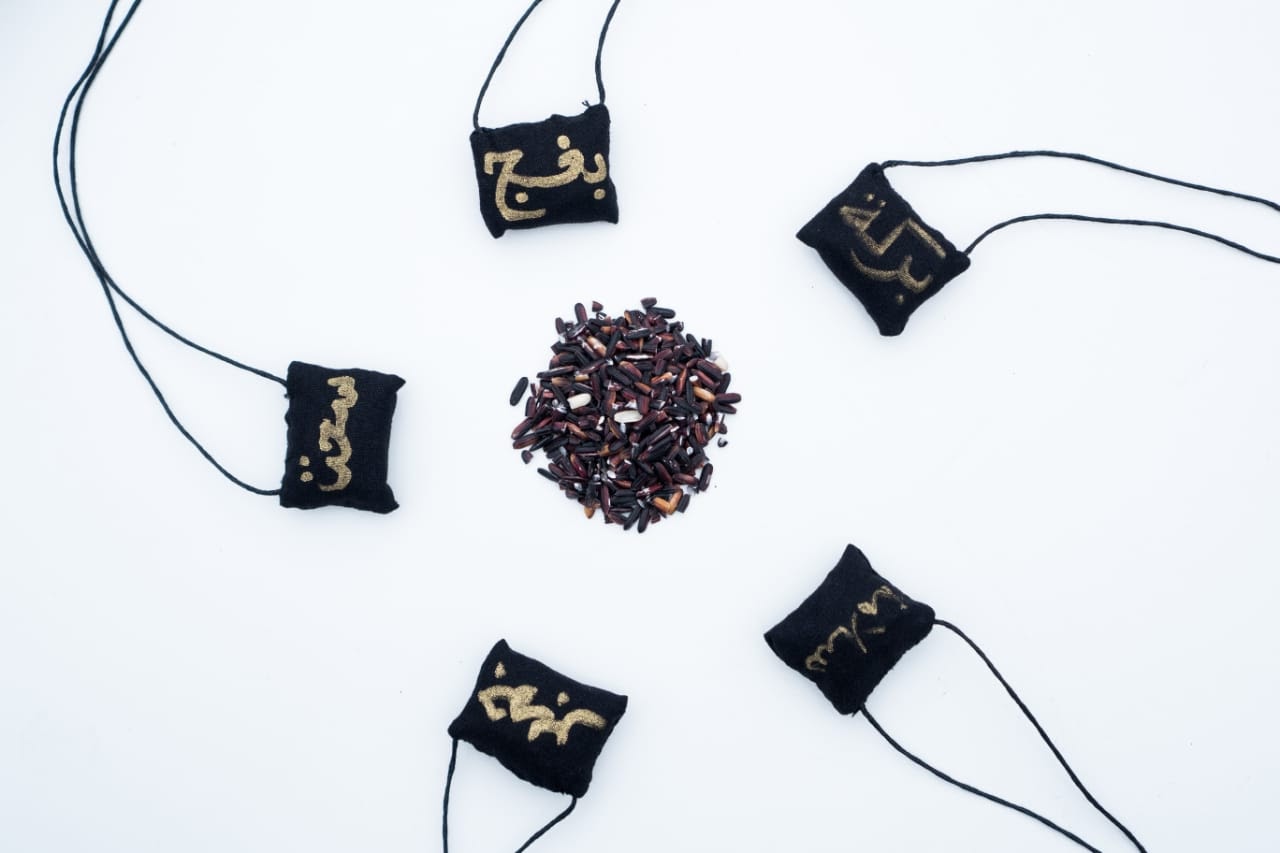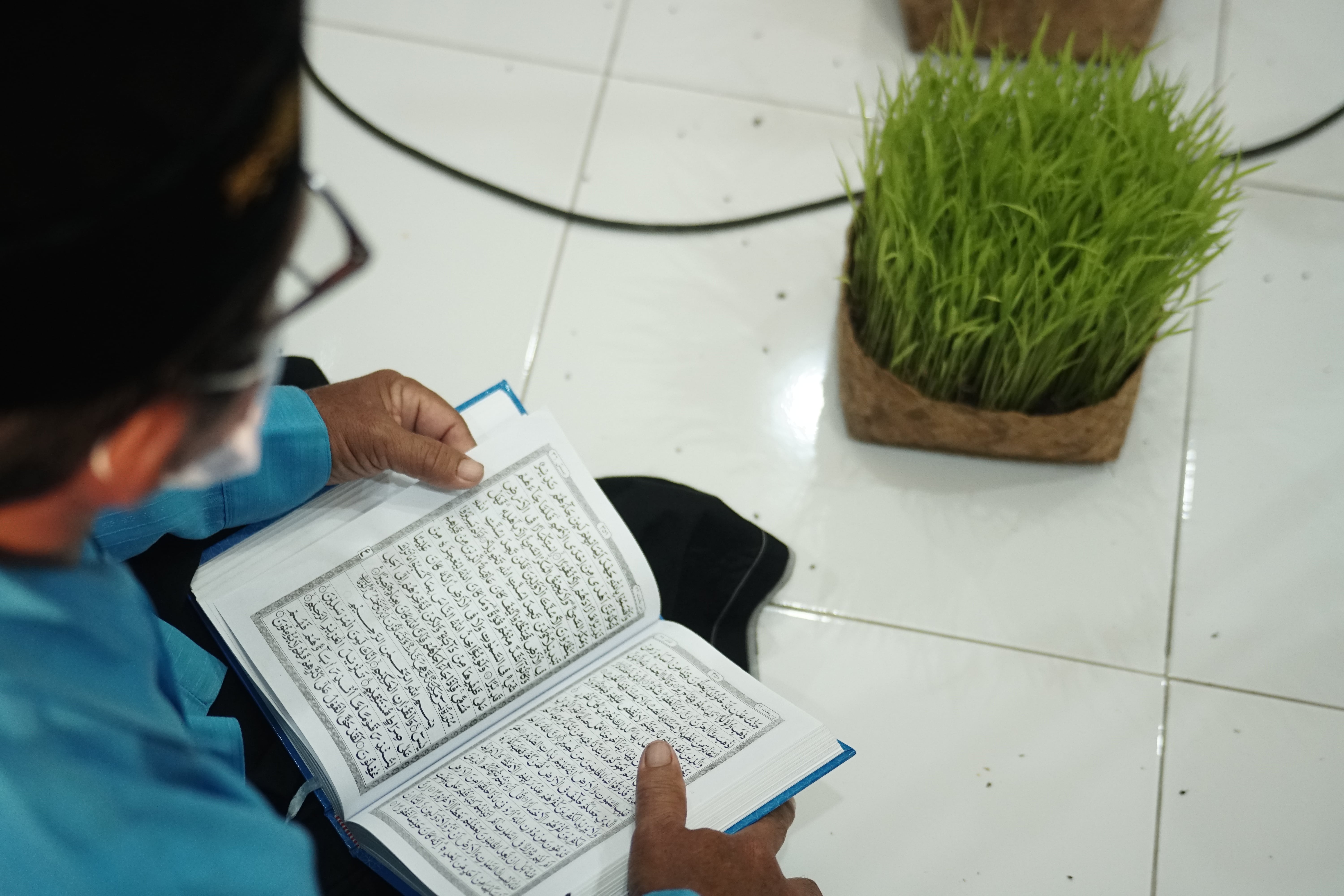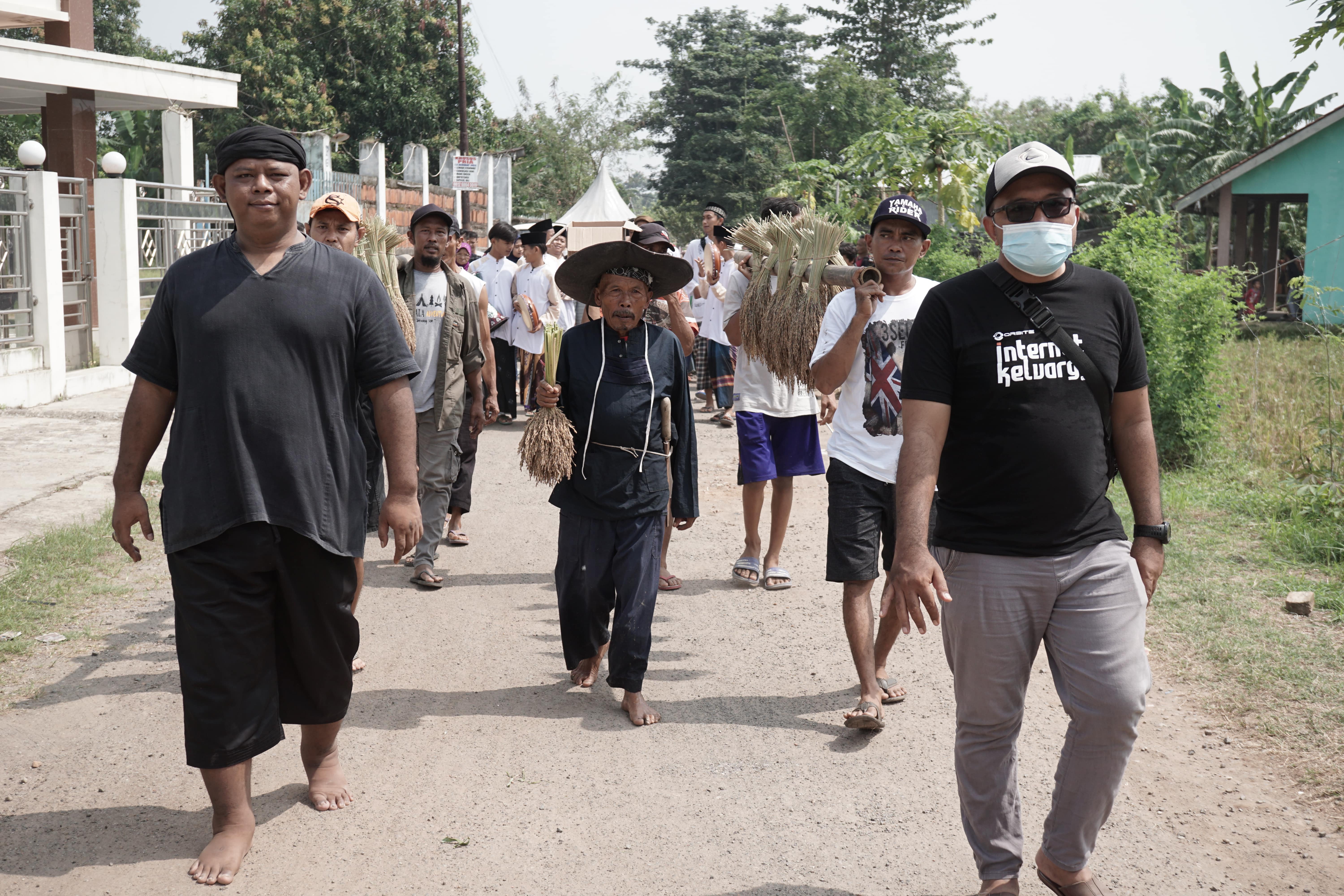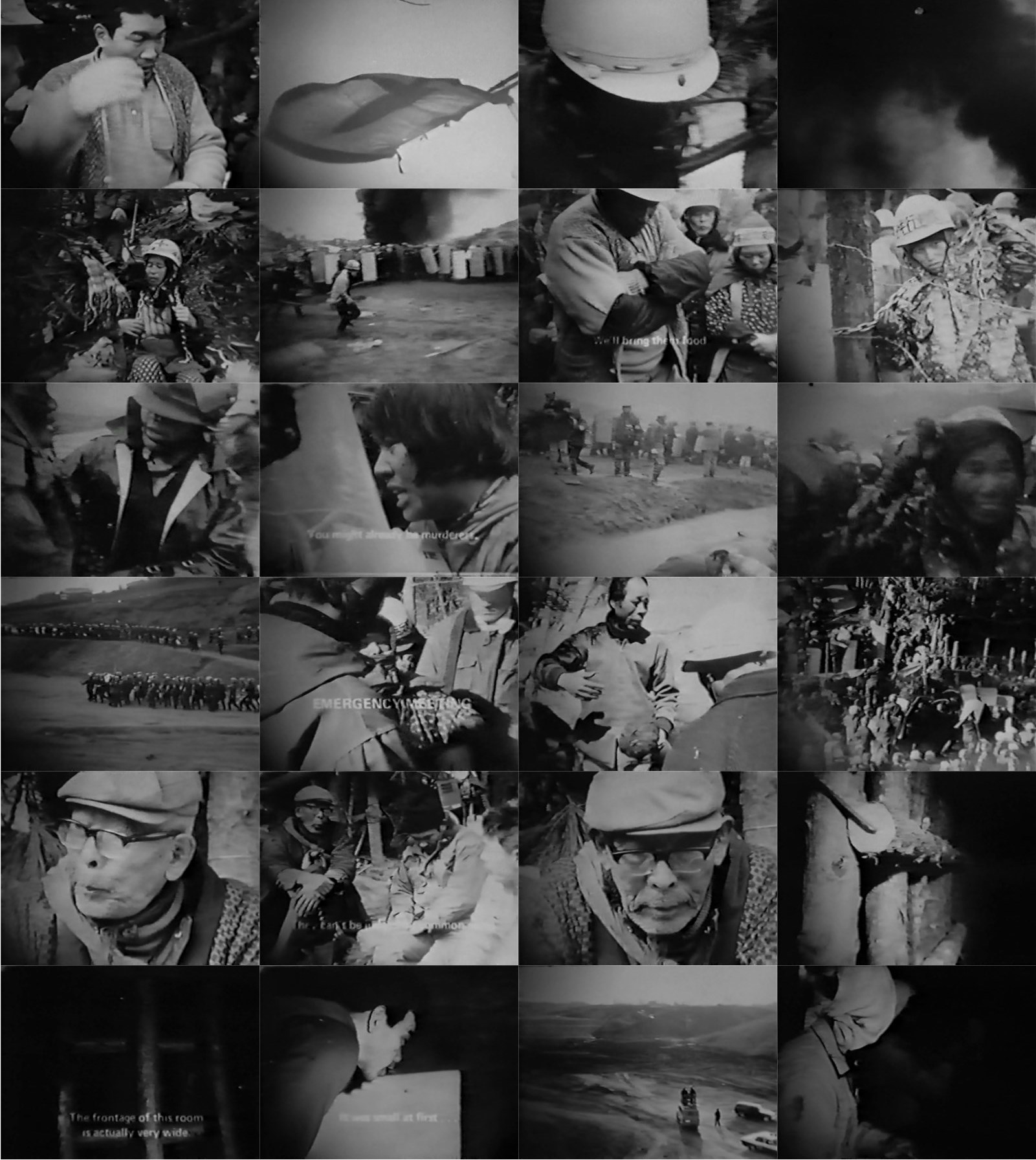Performing The Sacredness:
Seed and Land

The Black Rice and Amulet in Arabic text for the rituals. This is an object as a medium of praying, believed to bring good things for the planting process and the rice fields. Written in Arabic, the text is actually Sundanese words that mean Bagja (contentment), Sehat (healthy), Berkah (blessing), Jembar (prosperous), and Salamet (guarded). Image credit: Bunga P. Siagian
Performing The Sacredness: Seed and Land
Bunga P. Siagian
Abstract:
In 2013, Jatisura village in Jatiwangi --- approximately 3 hours driving from Jakarta made a project called ‘Sebelum Semua Menjadi Seperti Jakarta’ (Before everything turned to be Jakarta), a fun yet critical articulation to show how villages in Java, and Indonesia in general, facing the threat of urban expansion. Land grabbing for the sake of economic acceleration, together with rapid infrastructures growth has changed the cultural, social, and physical landscapes of villages, including Jatiwangi. Disappearing rice fields is the most imaginable and nearby visible. In the midst of imagining the future without rice fields, I am thinking of the habitat of the rice field itself; Animals, microorganisms, farmers, soil, rice seed, and a lot of other invisible things. As the owner of the land, do they ever organised a resistance? What kind of possible struggle they could do together? What kind of form of organisation they could have. In the effort of locating the organisation of things, this speculative writing will bring the story of the Black Rice, the sacred and forbidden rice in the agricultural history in Java. The essay will explore how the farmers in Wates village in Jatiwangi performing the sacredness of The Black Rice and consequently creates poetic narrative and action collaboratively to challenge the dynamic of land ownership.
How do we preserve the memory of rice, seeds and fields? In the name of development and economic growth, everyday lives have never been the same . It is visible in the changing visuals of the villages in Jatiwangi, West Java, that I have been facing for the past four years; a ruthless development of toll roads, an international airport and factories in place of dwindling farmlands, roof tile factories, and rice mills. Inevitably, this is followed by the expansion of rented houses with asbestos roofs for migrant workers from neighbouring regions. Nevertheless, amidst a certain future of land without rice fields, I would like to reflect on how the inhabitants in Jatiwangi have responded in defending their land and its constituents.
I
I was reminded of a Japanese documentary series between 1967 - 1977 by Shinsuke Ogawa - “The Battle Front For The Liberation of Japan – Summer In Sanrizuka” (hereafter cited as "Sanrizuka"), “Narita: The Peasants of the Second Fortress” (hereafter cited as "Narita") and “Narita: Heta Village” (hereafter cited as "Heta") - that brought up a similar issue. The series, Sanrizuka or Narita asserted Ogawa's political standing with the people of Sanrizuka, particularly of the village of Heta who at the time was very resistant against the state development project that seized the residents’ land for Narita International Airport.
Sanrizuka frames the people’s resistance. Direct resistance in the film is contextualised within the political background to show how the resistance is the only option left at the time. Through the memories of Heta villagers, audience is introduced to an unabridged knowledge of what constitutes human life and the rural civilisation ― a dialogue on the past, territory, history, culture, artefacts, cultural locations, forms of interactions, activities narrated with images. Subsequently, the images set up a statement on the importance of the elements inherent in the land for civilisation. The land that is disputed is not only a physical reality without a value; it embodies myth, religion, tradition, kinship, memory, social relations that determine patterns of interactions and communications among the people.
In Narita, the residents as a communal system are in dialogue with each other, demonstrating their awareness in formulating a theory of progress that consolidates follow-up strategy for actions of direct resistance. These actions were formulated and analysed by the residents themselves, assisted by students and members of the radical left, with the aim of pushing the accumulated power to drive an important change and be able to withstand pressure from the opposing party. At one point, the political movement culminated in a protest by residents, students, and leftist groups of twenty thousand people against thirty thousand police personnel ― a mob that Abbe Mark Nornes has called "one of the most traumatic social struggles in modern Japanese history".
In Heta, ‘losing with honour’ is well-suited to describe the people of Sanrizuka, which Ogawa describes as a community empowered by its own history. There is a subjective mass movement as a response to non-ideal realities of the system and the anatomy of the society itself. The interesting part is that the movement did not just die down, it was followed by philosophical and political reflection afterward ― whether as a practical movement it was able to actually transform the social reality. The most important part is that the reflection led to a proposition to seek for experimental forms of struggle against similar conflicts in all lands of the world.
II
Residents of Wates Village, Jatisura, have been living in a surrealistic manner for a long period of time. Although the ever growing descendants of the villagers still live on village land, they have never had clear land ownership status since Indonesia's independence. The land, confiscated by the Japanese during the colonial era under colonialism, was not returned to the residents after independence. Instead, it was taken over by the Indonesian Air Force1. The response of the people of Wates to the land polemic certainly differs from Sanrizuka, as represented by Ogawa’s films. However, I intend to take the question proposed in the third part of Ogawa's film seriously by pondering on the form and experimentation of the struggle defending the land and its history. Thus, I will not describe how the Wates people organise themselves. The centre of this section is a “Black Rice” variety otherwise known as beras wulung, planted by Wates residents in a plot of village land.

The man pray for the black rice sprout that is ready to be planted in the village mosque. This ritual is carried out on the night before the planting process the next morning. Photo credit : Alma Noxa
Black Rice has a special significance. In China, historically, black rice had been recognised as forbidden rice since it was a food only for the royalty2. The commoners were not allowed to consume it. Similarly, the black rice, also known as beras wulung, is a food reserved only for high-ranking officials in the Surakarta Palace, as well as, part of royal rituals in Java3. Those who were not part of the royals will be ‘cursed’ if they consume it. The rice is known for its high anthocyanin which is beneficial for antioxidants and anti-cholesterol, hence, it is sometimes called a ‘superfood’. The black rice can even be used as medicine.
In other parts of Indonesia, black rice is also associated with black magic. Pak I’ing, one of the Wates residents and a rice producer, shared that once in Subang, West Java, there was a story about a village that practiced black magic in the past. According to the story, the villagers are still planting black rice today and the grain colour is perfectly black ― an impossible outcome if black rice was grown outside Subang. According to Pak I'ing, black rice grown elsewhere tends to have white patches on the rice husk. Thus, the land in Subang is exceptional. It has become a sacred land. Pak I'ing's story piques my interest ― it is a testament of a close relationship between rice seed and the history of the land where it grows.
Under the guidance of an organic farmer in Garut after a short pilgrimage, Wates residents have been regularly planting black rice in a patch of land called Tanah Segitiga (‘Triangle Land’). The land is in the outermost of the boundaries between Wates Village, other villages and the Air Force, or in other words, no man’s land. There had been discourses on the establishment of the Air Force post on the land, although this has not yet been effectuated. As a result, the residents collectively turned the area into a cultural space before the Air Force executed the plan.. The land is planted with black rice organically, using a cultural approach. The main idea is to re-link religious activity with productivity. With the slogan, “prayers in the fields”, residents created new rituals for the community. Prayers for the seeds before planting, praises during the planting process, recitation of the Qur’an in harvesting seasons, and many others. Every year, when the harvest season arrives, Wates’ residents gather at the rice field to celebrate the harvest. The residents are enthusiastic to engage in the entire ceremony, including the rituals during the harvest. Tanah Segitiga has turned into a cultural space for the villagers, where, on the land, they create collective memories and shape the history of their village. In the context of Wates people, the 'reclaiming' of the land is manifested through the embedded culture of their everyday actions.

Wates Village residents paraded the black rice that had been harvested around the village.
Photo credit : Ahmad Suja'i
III
These activities have turned Tanah Segitiga into a kind of revered sacred land. The word ‘sacred’ (keramat) itself in Javanese tradition is defined as existing in a complex relationship with history, memory, myths, traditions of the past. Thus, an object or place ascribed with the status ‘sacred’ traditionally holds a profound position within the society. It is to the sacred that the people customarily distinguish their identity. Amidst land conversion and transfer of ownership by the power that haunts the villages, sacred land is the most difficult to touch let alone disturb by outsiders ― not only because of the ominous myths of the ghost residents who with no hesitation will act upon revenge on the unrightfully seized land, but also the living residents who refuse to be severed from their relationship with their history and ancestors. In the midst of land contestation in Jatiwangi, the lives of the Wates people are pressingly vulnerable and it is on the sacred land, planted with black rice, that we can imagine (and, concurrently, depend on) the future of a collective living space to survive.
It is the black rice that turned Tanah Segitiga into a sacred land. It is also the black rice that encourages the spiritual practices of Wates residents in producing food and reconnects the ecological awareness of the residents in formulating a vision for the future. The same black rice, known as forbidden rice, ritual rice, superfood rice, medicative rice, was mentioned by the Prophet Muhammad in the Book of Thibbun Namawi. By performing the legacy of memory, knowledge, and narrative of sacredness from the past attributed to black rice, or what we may call as performing the sacredness, the people of Wates have created alternative possibilities for the history of their community.
Maybe for those who believe only in actions of counter-hegemony, a simple story on the collaboration between the black rice and the residents of Wates village dealing with the land-grabbing practice of the neoliberal regime for their common future sounds overly romantic. Nevertheless, I do not intend to conclude this article by arguing what we should believe and what we should do ― they say, it is the root cause of the stagnation of transformative social movements. What I am suggesting instead is simply a way to remember the grains of rice and the rice fields. Remember the story you read today - a heroic story about the resistance of the villagers led by the seeds of the black rice against the master thieves.
References
-
Dadi Haryadi (2019, 16 August),Terlibat Sengketa dengan TNI AU, Puluhan Warga Kampung Wates di Majalengka Tak Kantongi Sertifikat, ayocirebon.com. Source
-
Jeremy Cherfas (2015, 5th October), How 'Forbidden' Black Rice Flourished For Millennia, The Salt. Source
-
Kristamtin (2009, 23 May), ‘Mengenal Beras Hitam Dari Bantul’, Tabloid Sinar Tani. Source
-
Badan Kajian Pertanahan & Kyai Maman Faturohman (Hosts). (2018), Tausiyah Padi Hitam [Audio podcast], Soundcloud. Source (Translated transcript available here)
Keywords: heirloom seeds, black rice, beras wulung, spiritual, sacredness
The original article was first written in Bahasa Indonesia.
Published 16 October 2021.
.jpg)

.jpg)